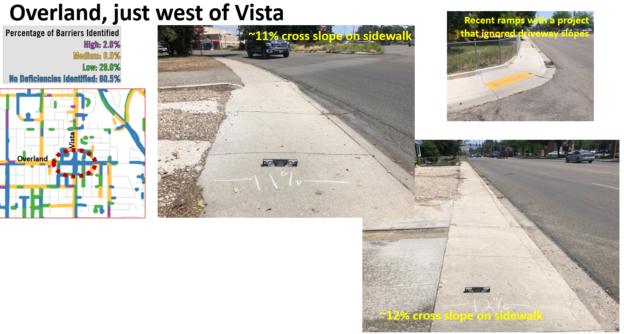By Don Kostelec
August 4, 2020
We saw a series of promotional items from various agencies about their commitment to implementing the Americans with Disabilities Act (ADA) as it approached its 30th Anniversary on July 26, 2020,
NCDOT bragged about curb ramps. I chuckled because I’ve spent more than a decade pointing out how they still build curb ramps that don’t have flat landings at the top of them and they have regularly ignored other facets of accessibility in engineering of their roads.
Here in Boise, the Ada County Highway District Commission passed a resolution at its July 22, 2020, meeting titled “A PROCLAMATION OF RECOMMITMENT TO FULL IMPLEMENTATION OF THE AMERICANS WITH DISABILITIES ACT (ADA).”
This is what happens when feel-good and well-intended resolutions like this start to stray from what is constructed in the field. Overall, ACHD does a great job with compliance when it builds sidewalks and curb ramps. I’m happy that I worked at that agency from 2002-2008 and helped blaze a trail for ADA compliance in the public right of way that ACHD manages. Like many other agencies, it still misses the mark on other facets of ADA compliance.
The July 22 resolution read (emphasis added):
- “The Ada County Highway District does hereby reaffirm that the full promise of the ADA will only be reached if the Ada County Highway District remains committed in our efforts to fully implement the ADA, and that the Ada County Highway District celebrates and recognizes the progress that has been made to fulfill the promise of the ADA.”
Fully implement means fully implement, right? Not so fast.
ADA requires curb ramps to be upgraded to current standards when a major alteration occurs on a road. This requirement is most-often tripped by a resurfacing project along a street that has sidewalks but non-compliant ramps.
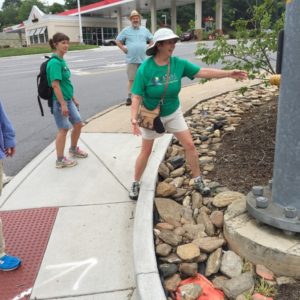
Agencies have become more consistent with meeting this requirement in recent years. However, there still exists a misconception that if the agency upgrades the ramps then it means they’ve made the corridor compliant. Upgrading the ramps meets the federal mandate, but if the pedestrian push buttons and driveways along the route remain non-compliant then the ramps have only addressed part of the problem. The route remains non-compliant and people in wheelchairs may still be forced to use the street instead of sidewalks due to excessive cross slopes on driveways.
Ironically, a month earlier ACHD’s Commission meeting included a great example of how they may be meeting the federal mandate but are not fully implementing ADA. There was an agenda item at the June 10 meeting for approval of a contract for the resurfacing of Owyhee Street from Cherry to Overland on the Boise Bench.
ACHD completed a neighborhood sidewalk project on Owyhee Street a few years ago that resulted in filling sidewalk gaps and replacing curb ramps. In their eyes, this corridor requires no other changes to be ADA compliant because they viewed that sidewalk project as getting the job done.
On the contrary, where existing sidewalks were in place south of Nez Perce, ACHD did not upgrade the driveway crossings that have non-compliant cross slopes (image below). This corridor won’t be touched from an accessibility perspective for a long time if this resurfacing project ignores these driveways.
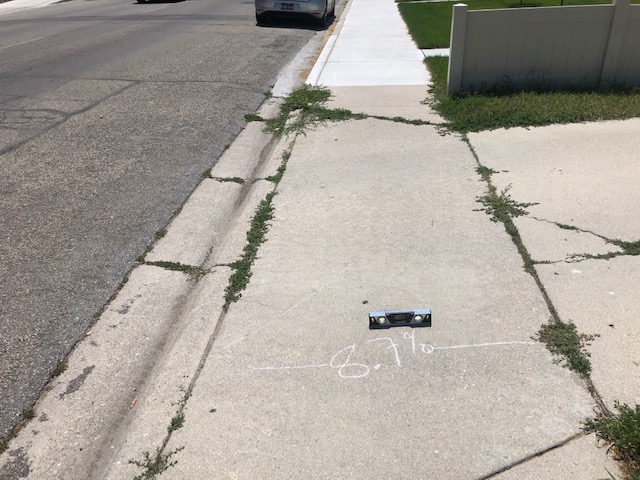
ADA compliance was discussed with regard to the Owyhee project after my testimony. At the 54:15 mark of the video (below), ACHD’s Deputy Director asserts that the project ” was designed to federal standards.”
At the 57:55 mark, Commissioner Sara Baker asked “Doesn’t this project bring up to standards the ADA requirements?” At the 58:00 mark, the Deputy Director re-affirmed that it did. I’m not sure what color the sky is in a world where they believe 9% cross slopes meet ADA requirements.
I attempted on two occasions to schedule an in-the-field meeting on Owyhee with ACHD staff and its director but nothing came of it. Shortly after these requests is when they passed the proclamation asserting their commitment to fully implement ADA.
This brings us back to their proclamation: There’s a difference in doing the minimum that ADA requires versus “fully implementing” ADA. The Owyhee project is an example of that.
Is ACHD following federal law with what they’re doing on the Owyhee resurfacing project? Yes. Will Owyhee between Overland and Cherry be ADA compliant when that project is complete? No.
Why would ACHD not take the opportunity to fix these driveways when it’s already going to be out there doing a major project? Highway agencies don’t do only the minimums on things like travel lane widths when they widen a road. They fully implement the improvements for lane width and number of lanes.
I attempted to find the root of this problem, which appears to stem from ACHD’s recently-passed ADA Transition Plan. In that plan is a map that shows the ADA deficiencies they would have identified in the self assessment. That ADA Transition Plan map shows which routes have sidewalk deficiencies, with segments shown as blue lines identified as having none. The Transition Plan document does not address driveways or recommend a program to retrofit them.
When I looked at the Transition Plan map and zoomed in on Owhyee street, it was marked with a blue line. If the project managers were intent on truly making the corridor ADA compliant, they would have relied on field work to find this deficiency instead of using the map to assume there were no issues. The image below shows two of a driveway crossings on Owyhee where I used a smart level to measure the cross slope and marked it with chalk.
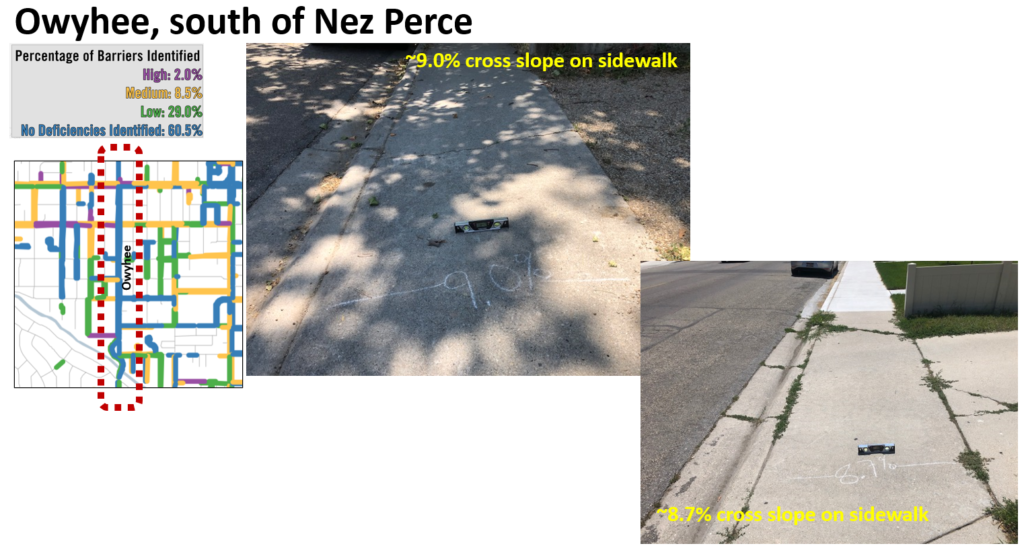
On my journey back home I discovered driveway cross slopes were a consistent problem in their inventory and project implementation. Owyhee is a collector roadway with fairly low speeds and traffic volumes. Overland Road at Vista Avenue, however is a much more treacherous route for anyone outside of a car.
The illustration below shows another area where the Transition Plan identified no deficiencies, curb ramps have been reconstructed in recent years, but driveway slopes along this 35 mph route with 19,000 vehicles per day. Imagine being a person in a wheelchair trying to navigate that 11% cross slope pulling you toward the street as the pickup truck sweeps around that slip lane. This is what happens when ADA is not fully implemented.
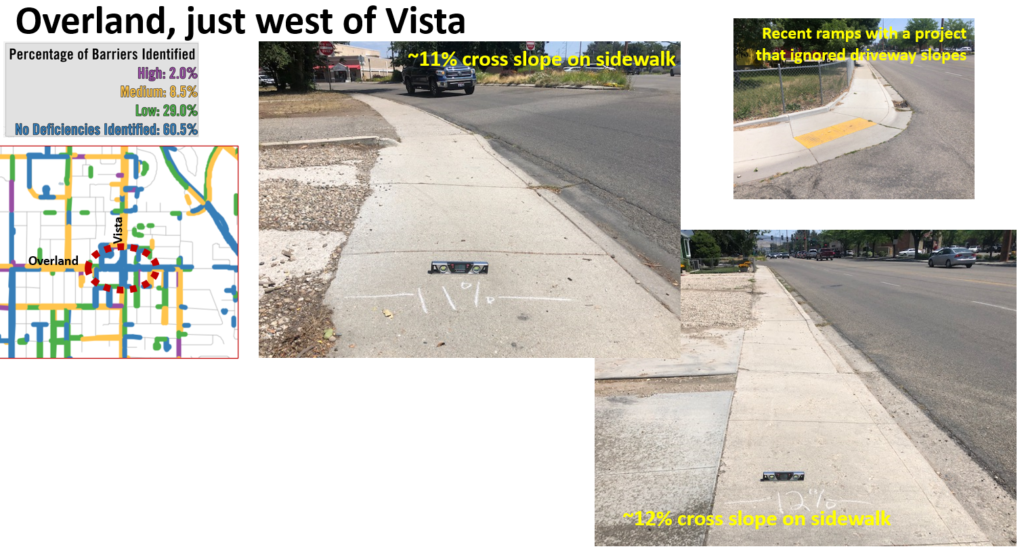
ACHD recently completed another sidewalk along Columbus Street from Overland to Kootenai, also on the Boise Bench. Streetview shows what it looked like before the sidewalk project was completed last year. The problem is ACHD defined the project limits as such that they failed to correct non-compliant driveways in a short section north of Overland, meaning they failed to make the full length of Columbus from Overland to Kootenai ADA-compliant.
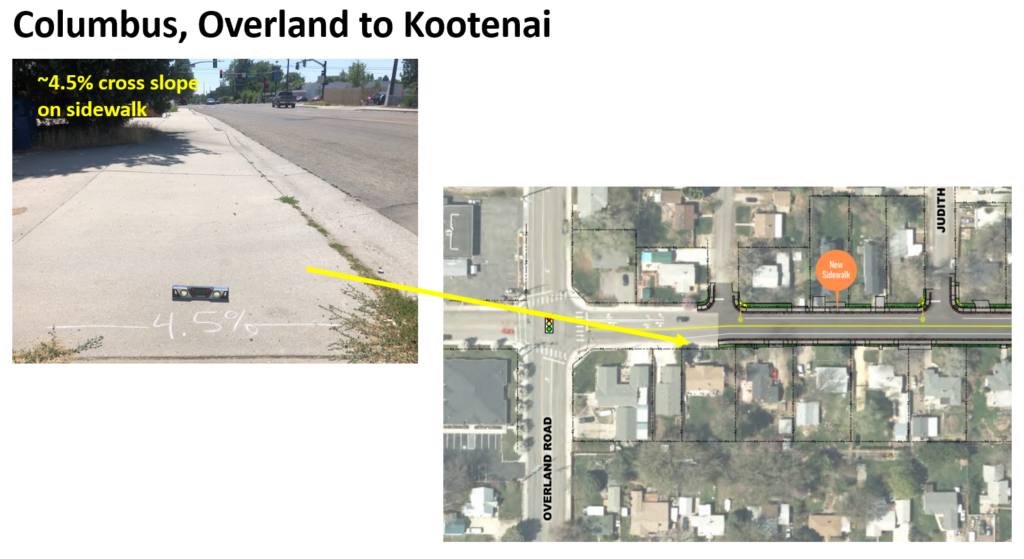
You know me well enough to know I’m not shy about calling this to an agency’s attention. Two days after they signed the proclamation I sent the ACHD Commissioners and Director this email requesting ACHD issue a change order to the Owyhee project to make the driveways compliant and that the Commission devote $100,000 a year to high priority driveway retrofits, with priorities defined by ACHD’s ADA Advisory Committee.
We’ll see if the words in their ADA proclamation turn into action so ADA is fully implemented. I’ll keep you posted!

